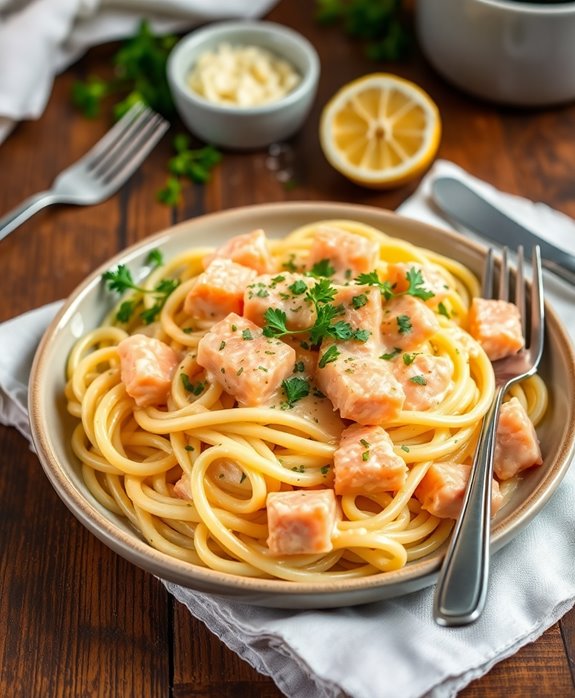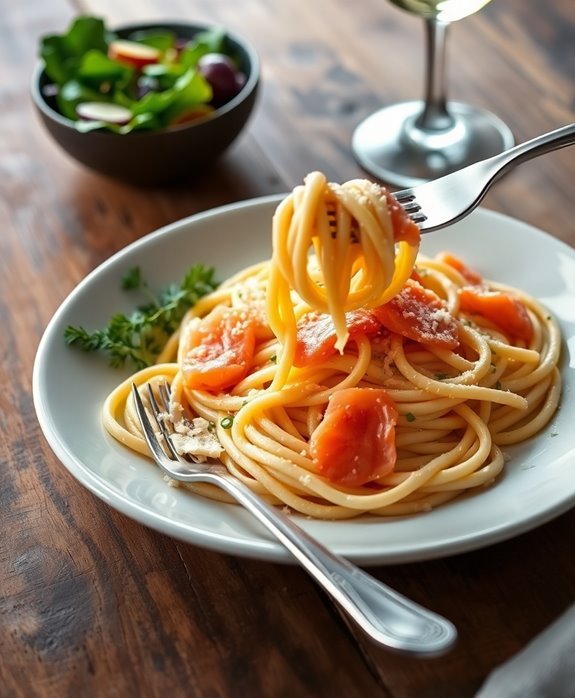While the decadence of Alfredo sauce often brings to mind indulgence, pairing it with the health benefits of salmon creates a unique culinary balance. You might be wondering how to achieve that perfect blend of creamy richness and nutritional value. This dish not only satisfies your taste buds but also elevates your dinner experience. By understanding the key steps in the preparation process, you can transform a simple meal into something extraordinary. Let’s explore the essential elements that make this recipe both delicious and wholesome.
Tips and Tricks
- Start by pan-searing a 1 lb salmon fillet in 2 tbsp olive oil until cooked through, then flake it into bite-sized pieces.
- Sauté 2-3 minced garlic cloves in butter to create a flavorful base for your Alfredo sauce.
- Combine 1 cup heavy cream and 1 cup grated Parmesan cheese in the pan, stirring until the cheese melts and the sauce thickens.
- Cook 8 oz fettuccine pasta al dente, then gently mix it with the sauce and flaked salmon for a harmonious blend of flavors.
- Garnish with fresh parsley and consider adding a squeeze of lemon juice for brightness before serving.
History
When you think of Salmon Alfredo sauce, you might envision a creamy, indulgent dish that perfectly complements pasta, but its origins are rooted in a blend of culinary traditions. The Alfredo sauce itself hails from Italy, credited to Alfredo di Lelio, who concocted it in the early 20th century as a simple mixture of butter, cream, and Parmesan cheese. This richness became a beloved staple, evolving into numerous sauce variations across the globe.
In the United States, chefs began experimenting by adding different proteins, like salmon, to enhance the dish’s flavor profile. The use of salmon not only adds depth but also incorporates health benefits, making your meal more nutritious. Additionally, the combination of salmon and pasta creates a delightful harmony that enhances the overall dining experience.
As you explore Salmon Alfredo, you’ll find that it’s not just about the sauce; it’s a reflection of how global culinary influences can create something uniquely satisfying.
Today, you’ll encounter countless interpretations of this classic combination, showcasing regional ingredients and personal preferences. Whether you prefer a lightened version with herbs or a traditional, decadent sauce, each variation tells a story, connecting you to its rich culinary origins.
Recipe

Indulge in a creamy, rich Salmon Alfredo Sauce that perfectly complements your favorite pasta. This dish combines the delightful flavors of fresh salmon with a luscious Alfredo sauce, creating a meal that’s both comforting and sophisticated. Whether you’re hosting a dinner party or enjoying a quiet night in, this Salmon Alfredo Sauce is sure to impress.
To make this dish, you’ll need just a few key ingredients that come together to create a harmonious blend of flavors. The combination of garlic, cream, and Parmesan cheese forms the base of the Alfredo sauce, while succulent pieces of salmon add a delightful seafood twist. This recipe is simple enough for a weeknight dinner but elegant enough to serve on a special occasion.
Ingredients:
- 8 oz fettuccine pasta
- 1 lb fresh salmon fillet, skinless and boneless
- 2 tbsp olive oil
- 3 cloves garlic, minced
- 1 cup heavy cream
- 1 cup grated Parmesan cheese
- Salt and pepper, to taste
- Fresh parsley, chopped (for garnish)
To prepare the Salmon Alfredo Sauce, start by cooking the fettuccine according to package instructions until al dente.
While the pasta is cooking, heat the olive oil in a large skillet over medium heat. Season the salmon fillet with salt and pepper, then add it to the skillet, cooking for about 4-5 minutes per side or until it’s cooked through and flakes easily with a fork.
Remove the salmon from the skillet and set it aside. In the same skillet, add the minced garlic and sauté for about 1 minute until fragrant.
Pour in the heavy cream, stirring to combine, then add the grated Parmesan cheese. Cook for a few more minutes until the sauce thickens slightly.
Flake the cooked salmon into bite-sized pieces and gently fold it into the Alfredo sauce. Serve the sauce over the cooked fettuccine and garnish with chopped parsley.
When making Salmon Alfredo Sauce, consider using fresh salmon for the best flavor and texture. If you prefer, you can also substitute the salmon with shrimp or chicken for a different twist. Additionally, be mindful of the heat when cooking the sauce; cooking it too quickly can cause the cream to separate. For a touch of brightness, consider adding a squeeze of lemon juice or some zest before serving. Enjoy your delicious meal!
A salmon melt recipe can also be a delightful way to enjoy salmon in a different format, proving the versatility of this nutritious fish.
Cooking Steps
To create your delicious Salmon Alfredo sauce, you’ll start by preparing the salmon fillet to guarantee it’s perfectly cooked.
Next, sauté garlic in butter to infuse the dish with rich flavor before adding cream and Parmesan for that creamy texture you love.
Finally, incorporate fresh spinach and toss in the cooked pasta, bringing everything together for a mouthwatering meal. Additionally, cooking the salmon in a toaster oven ensures even heat distribution, resulting in a tender and flaky texture.
Step 1. Prepare the Salmon Fillet

Starting with fresh, high-quality salmon fillets makes all the difference in your Alfredo sauce. Choose fillets that are bright in color, firm to the touch, and have a clean ocean scent. Not only does salmon taste amazing, but it also offers numerous health benefits, such as being rich in omega-3 fatty acids, which promote heart health and reduce inflammation.
To prepare your salmon, start by rinsing the fillets under cold water to remove any residual scales or impurities. Pat them dry with paper towels, ensuring they’re moisture-free for better searing. Next, season both sides generously with salt and pepper, allowing the flavors to shine through.
When it comes to cooking techniques, you can choose to grill, bake, or pan-sear your salmon. Each method has its unique charm, but pan-searing gives you that delightful crispy skin while keeping the inside tender and flaky. Additionally, cooking salmon at the right temperature helps retain its nutritional value and flavor, making it a fantastic choice for your meal.
Heat a skillet over medium-high heat with a drizzle of olive oil. Once the oil shimmers, carefully place the fillets skin-side down, cooking for about 4-5 minutes per side. This technique locks in moisture and enhances the overall flavor, setting the stage for your delicious Alfredo sauce.
Step 2. Sauté Garlic in Butter

With the salmon perfectly cooked and resting on a plate, the next step is to create a rich and flavorful base for your Alfredo sauce.
Start by selecting your butter type; unsalted butter is a great choice, as it allows you to control the saltiness of your dish. Heat a skillet over medium heat and add about two tablespoons of butter. Let it melt, swirling it around the pan until it starts to foam.
Now, it’s time to add the star player: garlic. Mince a couple of cloves, and toss them into the bubbling butter. The aroma will fill your kitchen, and you’ll instantly appreciate the garlic benefits, such as its ability to boost your immune system and enhance heart health.
Sauté the garlic for about 1-2 minutes, stirring frequently to prevent it from burning. You want it to become fragrant and golden, not brown.
Once the garlic reaches that perfect golden hue, you’ve created a deliciously aromatic foundation for your Alfredo sauce. Norwegian salmon is known for its rich flavor and healthy omega-3 fatty acids, making it a perfect pairing with creamy sauces. The next steps will build on this flavor, so savor this moment as you prepare for the creamy goodness to come.
Step 3. Add Cream and Parmesan

After the garlic has reached that fragrant golden color, pour in a cup of heavy cream, letting it cascade into the skillet. You’ll notice the sizzling sound as the cream meets the heat, creating a rich, velvety mixture.
Use heavy cream for a luscious texture, but you can also experiment with half-and-half or even a lighter cream type if you prefer a less indulgent option.
Stir the cream gently, allowing it to blend seamlessly with the garlic and butter. As the sauce begins to thicken, it’s time to introduce the star ingredient: Parmesan.
Grate about a cup of Parmesan cheese—consider using Parmigiano-Reggiano for a nutty flavor or Pecorino Romano for a sharper bite. Both parmesan varieties will elevate your sauce, so choose based on your taste.
Sprinkle the grated cheese into the creamy mixture, stirring continuously until it melts and incorporates fully.
You’ll want the sauce to be smooth and creamy, with the cheese adding a delightful saltiness. This is where the magic happens, transforming the sauce into a luxurious coating for your salmon and pasta.
Pair this sauce with delicious salmon for an unforgettable meal that balances flavors beautifully.
Enjoy every moment of this creamy indulgence!
Step 4. Incorporate Fresh Spinach

As you plunge into the next step of your Salmon Alfredo, toss in a generous handful of fresh spinach to the creamy sauce. The vibrant green leaves won’t only brighten up your dish but also add a wealth of nutrients. Spinach is packed with vitamins A, C, and K, along with essential minerals like iron and calcium. By incorporating it, you’re enhancing both the flavor and the health benefits of your meal.
Gently stir the spinach into the sauce, allowing it to wilt slightly and absorb the creamy texture around it. In just a few moments, you’ll see the spinach transform, melding beautifully with the Alfredo sauce. The rich creaminess of the sauce complements the earthy flavor of the spinach, creating a delightful balance.
As you watch the spinach soften, you’ll notice how it adds a lovely depth to the dish. This step not only boosts the nutritional profile but also contributes a pop of color and freshness that makes your Salmon Alfredo visually appealing. Adding spinach also introduces healthy omega-3 fatty acids, which are beneficial for heart health.
Keep stirring until the spinach is tender, ensuring every bite is infused with its goodness. Your sauce is now richer and healthier than ever!
Step 5. Add Cooked Pasta to Sauce

Now that your creamy Salmon Alfredo sauce is infused with fresh spinach, it’s time to bring everything together by adding your cooked pasta. Choose your favorite pasta type—fettuccine, penne, or even rotini all work wonderfully here. Each pasta type brings a unique texture, so pick one that you love or have on hand.
Once your pasta is perfectly al dente, drain it and immediately add it to the sauce. Use tongs or a large spoon to gently mix the pasta into the sauce, ensuring every strand or piece is coated in that rich, velvety goodness. The heat from the pasta helps the flavors meld together beautifully, creating a harmonious dish.
If you’re feeling adventurous, consider experimenting with sauce variations. You could add a splash of lemon juice for brightness or a sprinkle of red pepper flakes for a bit of heat. Additionally, incorporating diabetic-friendly ingredients can enhance the dish while keeping it suitable for your dietary needs. Stir well to incorporate any additional flavors, and let it simmer for a minute or two, allowing the pasta to soak up the sauce.
Serve immediately, garnished with fresh herbs or grated Parmesan for an extra touch. Enjoy your delicious, homemade Salmon Alfredo!
Nutrition Facts
When you’re savoring a rich salmon Alfredo sauce, it’s crucial to understand the nutrition facts behind this delicious dish. This creamy sauce, often enjoyed with pasta, packs a punch in both flavor and nutrition. Typically, a serving of salmon Alfredo can contain around 400 to 600 calories, depending on the portion size and ingredients used.
Salmon, the star of this dish, isn’t only a tasty addition but also offers numerous health benefits. It’s loaded with omega-3 fatty acids, which support heart health and reduce inflammation. Plus, salmon provides high-quality protein, essential for muscle repair and growth.
The creamy Alfredo sauce, made with butter, cream, and Parmesan cheese, adds richness while also delivering calcium and vitamin A. Additionally, incorporating low FODMAP ingredients can make this dish more approachable for those with specific dietary needs.
However, it’s crucial to watch the caloric content, especially if you’re watching your intake. If you’re looking to lighten it up, consider using lighter cream alternatives or reducing the amount of cheese.
Balancing indulgence with nutrition allows you to enjoy your meal while still caring for your health. So, immerse yourself and relish the flavors, knowing you’re treating your body well!
Final Thoughts
Understanding the nutrition facts of salmon Alfredo sauce can truly enhance your enjoyment of this dish. This creamy, rich sauce isn’t just indulgent; it’s packed with omega-3 fatty acids from the salmon, which are great for heart health.
Pairing it with whole-grain pasta can elevate the nutritional profile even further, adding fiber and essential nutrients.
When you get creative, you can explore various sauce variations to suit your taste. Consider adding garlic, mushrooms, or spinach to your Alfredo for an extra punch of flavor and nutrition. You might even try a lighter version with low-fat milk or a dairy-free alternative if you’re looking to cut calories.
As for pasta pairings, you can’t go wrong with fettuccine but don’t shy away from trying penne or even zucchini noodles for a fun twist. Additionally, the use of a salmon belly can add a unique richness and flavor to your sauce, making it even more delectable.
The key is to find a balance that excites your palate while still providing a wholesome meal.
Frequently Asked Questions
Can I Use Frozen Salmon for This Recipe?
Yes, you can use frozen salmon for this recipe! Just thaw it properly first. Using techniques like poaching or baking enhances its flavor, ensuring it cooks evenly and blends beautifully with your dish. Enjoy the meal!
What Pasta Pairs Best With Salmon Alfredo Sauce?
When you think of a silky river flowing, remember that fettuccine and linguine embrace creamy sauce textures beautifully. Their wide pasta types capture every drop, creating a delightful harmony with flavors that dance on your palate.
How Can I Make the Sauce Gluten-Free?
To make the sauce gluten-free, use gluten-free alternatives like rice flour or cornstarch for thickening. If you’re aiming for dairy-free options, try coconut milk or almond milk for a creamy texture without gluten or dairy.
Can I Add Vegetables to the Salmon Alfredo?
Did you know that adding vegetables boosts the nutritional value of meals by up to 30%? You can incorporate vegetable options like spinach or broccoli using sautéing or steaming techniques to enhance the flavor and texture of your dish.
How Do I Store Leftover Salmon Alfredo Sauce?
To store leftover sauce, let it cool, then transfer it to an airtight container. For ideal sauce preservation, refrigerate it and consume it within three to four days. You’ll enjoy its flavors even later!







